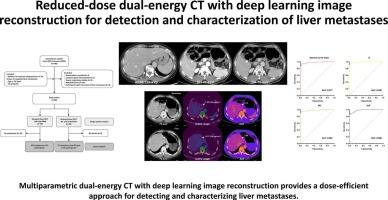基于深度学习图像重建的低剂量双能CT用于肝转移的检测和表征。
IF 3.3
3区 医学
Q1 RADIOLOGY, NUCLEAR MEDICINE & MEDICAL IMAGING
引用次数: 0
摘要
目的:比较深度学习图像重建(DLIR)的低剂量双能CT (DECT)与自适应统计迭代重建- veo (ASIR-V)的标准剂量单能CT (SECT)检测肝转移的图像质量和诊断性能,并评价DECT光谱参数用于鉴别转移与囊肿的疗效。方法:从2023年6月至2025年1月,80名已知或疑似肝转移的参与者被前瞻性纳入,并接受了对比增强肝脏CT,采用标准剂量SECT (n = 40, 120-kVp图像,ASIR - V 40%)或降低剂量DECT (n = 40, 40和70-keV虚拟单能图像[VMIs],高强度DLIR [DH])。评估客观图像噪声、噪比(CNR)、信噪比(SNR)、肝脏与病变的噪比(LLR)、主观图像质量、病变显著性、检出率。使用受试者工作特征(ROC)曲线评估光谱参数对区分转移和囊肿的诊断性能。结果:在低辐射剂量条件下,DH显著降低了DECT扫描的图像噪声。与AR40 120-kVp图像相比,剂量降低45%后,40kev和70kev具有DH的VMIs具有更高的CNR, SNR和LLR,更好的图像质量和相似的病变检出率以及更好或相当的病变显著性(P > 0.05)。利用光谱曲线斜率、碘浓度、归一化碘浓度和有效原子序数分别得到0.977、0.990、0.982和0.980的曲线下面积(AUC)值来鉴别转移与囊肿。结论:DLIR可有效降低DECT中40 kev和70 kev vmi的图像噪声,提高图像质量,在不影响转移诊断的情况下,实现45%的辐射剂量降低。DECT光谱参数能够准确区分转移瘤和囊肿。本文章由计算机程序翻译,如有差异,请以英文原文为准。

Reduced-dose dual-energy CT with deep learning image reconstruction for detection and characterization of liver metastases
Purpose
To compare image quality and diagnostic performance of reduced-dose dual-energy CT (DECT) with deep learning image reconstruction (DLIR) versus standard-dose single-energy CT (SECT) with adaptive statistical iterative reconstruction-Veo (ASIR-V) for detecting liver metastases, and to evaluate the efficacy of differentiating metastases from cysts using DECT spectral parameters.
Methods
Eighty participants with known or suspected liver metastases from June 2023 to January 2025 were prospectively enrolled and underwent contrast-enhanced liver CT with either standard-dose SECT (n = 40, 120-kVp images, ASIR‑V 40 %) or reduced-dose DECT (n = 40, 40- and 70-keV virtual monoenergetic images [VMIs], high-intensity DLIR [DH]). The objective image noise, contrast-to-noise ratio (CNR), signal-to-noise ratio (SNR), liver-to-lesion contrast-to-noise ratio (LLR), subjective image quality, lesion conspicuity, and detection rate were assessed. The diagnostic performance of spectral parameters for differentiating metastases from cysts was evaluated using receiver operating characteristic (ROC) curves.
Results
DH significantly reduced image noise of DECT scans in reduced radiation dose conditions. With a 45 % dose reduction, the 40- and 70-keV VMIs with DH showed higher CNR, SNR, and LLR, better image quality and similar lesion detection rates and better or comparable lesion conspicuity compared with AR40 120-kVp images (P > 0.05). The use of the spectral curve slope, iodine concentration, normalized iodine concentration, and effective atomic number yielded the area under the curve (AUC) values of 0.977, 0.990, 0.982, and 0.980 for differentiating metastases from cysts, respectively.
Conclusion
DLIR effectively reduces image noise and improves image quality of the 40- and 70-keV VMIs in DECT, achieving a 45% radiation dose reduction without compromising metastases diagnosis. DECT spectral parameters enable accurate differentiation of metastases from cysts.
求助全文
通过发布文献求助,成功后即可免费获取论文全文。
去求助
来源期刊
CiteScore
6.70
自引率
3.00%
发文量
398
审稿时长
42 days
期刊介绍:
European Journal of Radiology is an international journal which aims to communicate to its readers, state-of-the-art information on imaging developments in the form of high quality original research articles and timely reviews on current developments in the field.
Its audience includes clinicians at all levels of training including radiology trainees, newly qualified imaging specialists and the experienced radiologist. Its aim is to inform efficient, appropriate and evidence-based imaging practice to the benefit of patients worldwide.

 求助内容:
求助内容: 应助结果提醒方式:
应助结果提醒方式:


